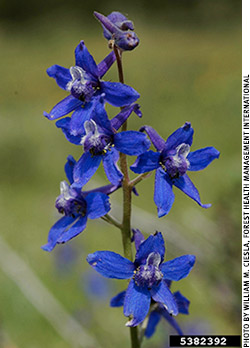Larkspur Alert
Larkspur poison concerns continue for cattle producers.
Last spring, cattle producers in Washington’s northern Columbia Basin experienced serious problems with larkspur poisoning. Following recent discussions with a producer who saw significant losses in 2015, it seems that larkspur may be as bad in 2016.
With the increased soil moisture and larkspur levels in 2015, cattle producers could see significant larkspur blooms as weather warms this spring.

Tall larkspur, a common poisonous plant that can kill cattle, may see significant blooms this year.
Larkspur is one of the deadliest, most commonly encountered poisonous plants for cattle on Western U.S. rangelands, usually occurring on foothill ranges in the spring, and in the mountains during summer.
Low larkspur has a spurred blue flower that grows on the top third of a single and unbranched stem. It is found on grassy hillsides and in sagebrush areas, where it may reach a height of 2 feet (ft.). Leaves alternate and are divided into deep, narrow lobes, and the stem is hollow.
Low larkspur tends to grow at lower elevations — unlike tall larkspur, which grows at high elevations — where it matures and becomes dormant before soil moisture is depleted. Low larkspur begins growing in early spring, often before other forages begin growth.
Larkspur can cause heavy cattle losses in infested grazing areas when it is highly palatable to cattle, especially during the flower stage. Larkspur toxicity is highest at the vegetative/bud stage and decreases as it matures. However, the palatability of larkspur for cattle increases as the plant flowers and matures into pods. The toxic window for most cattle death is when the plant flowers and matures into pods, and palatability of the plant is increasing.
Adverse weather conditions, like cold nights, can also greatly increase consumptions of larkspur. More information about the toxic window and risk of toxicity relative to palatability and toxicity levels can be found on page 5 of Grazing Tall Larkspur Ranges: A Livestock Producer’s Decision Making Handbook.
The lethal dose for cattle is about 0.5% of body weight, requiring only about 5.5 pounds (lb.) to 7.5 lb. of larkspur to kill a 1,100- to 1,500-lb. cow.
Sheep can tolerate larkspur at high levels, not experiencing lethal doses until about 2.0% of body weight or about 3.5 lb. for a 180-lb. ewe.
The toxic substances are a mixture of several alkaloids. These alkaloids and their relative toxicity and concentrations vary between individual plants, at different locations and between larkspur species. The method of toxicity has been identified as neuromuscular paralysis, leading to respiratory failure, bloat and often death. Signs of poisoning include nervousness, weakness, staggering gait, repeated falling, rapid irregular pulse, straddled stance, mild tremors, salivation, diarrhea, bloat, vomiting, convulsions and coma. Working cattle suspected of larkspur should be limited, because excitement and physical exercise intensifies all signs of poisoning. Death will usually occur within three to four hours of eating lethal amounts.
There is no proven treatment of larkspur poisoning. Conservative therapy, such as placing an affected animal on its brisket or chest with its head uphill to reduce bloating, is recommended. The most important thing is to avoid unduly exciting an affected animal until it can eliminate the toxins, because larkspur toxins cause paralysis of the neuromuscular system and limit an animal’s ability to breathe.
If a larkspur range is treated with herbicide, do not graze it until fall. The most common herbicide treatments increase palatability and do not decrease toxicity, even though the treatment will kill the plant. Contact your local chemical company for recommendations on herbicide options.
For more information on larkspur poisoning, view the handbook listed above (available at http://extension.usu.edu/behave/files/uploads/Fact_Sheets_App/Larkspur-Handbook-FINAL.pdf), or visit the USDA Poisonous Plant Research website (www.ars.usda.gov/Research/docs.htm?docid=9943).

Editor’s Note: Sarah Smith is a regional extension specialist in animal sciences, based at Grant-Adams County Extension.






